The market for pickups is booming. Never before have guitarists had so many great designs available to them, whether they’re looking to recapture the glories of vintage tone or upgrade and modify a modern guitar to suit specific needs.
It’s hard to know what you’re after, though, and what different types of pickups will do for you without understanding exactly what factors contribute to different sounds. To the end of laying down some of the basics, here’s an “Anatomy 101” for pickups.
As electromagnetic devices go, pickups are at the simple end of the spectrum. They don’t have the moving parts of more complicated gear siblings like dynamic microphones or speakers. But massive variables within the relatively few significant parts that make up any given pickup do contribute to enormous differences in sound.
How Pickups Work
Before digging into the components of the pickup, let’s look briefly at how they work. A speaker produces sound when the electrical signal hits an electromagnetic coil that’s attached to a flexible paper cone, suspended in proximity to a fixed magnet, causing the coil to move and the cone to vibrate along with it. Pickups work somewhat in reverse, but without the moving-part element of the equation.
A pickup is an electromagnetic device that produces a magnetic field through which the guitar’s strings pass. When you pick a string, its disruption of this magnetic field translates that motion into an electrical signal in a coil of thin wire wound within the pickup. This signal travels down the length of wire to your amplifier. In short, electromagnets can do two things: 1) translate an electrical signal into motion by exerting magnetic force or 2) do the reverse and translate motion into an electrical signal. Pickups do the latter.
The Major Components Of The Pickup
All electromagnetic pickups as used in traditional electric guitars require at least two primary components: a source of magnetism and a coil of wire. Some are as simple as a coil wrapped around a magnet—usually with some inert fiber, plastic base, or bobbin to hold everything in place. Fender Stratocaster and Telecaster pickups, for example, use six individual magnets—one for each string—with a coil wound around them.
Gibson’s Firebird mini-humbuckers or original Melody Maker single-coil pickups similarly have a bar magnet within a coil (or two, in the humbucker’s case). The more common Gibson types, though—the P-90 and the full-sized PAF-style humbucker—add steel pole pieces to the equation. These screw-like poles are threaded through the bobbin around which the coil of wire is wound, and into a base structure that puts them in contact with magnets mounted below the coil.
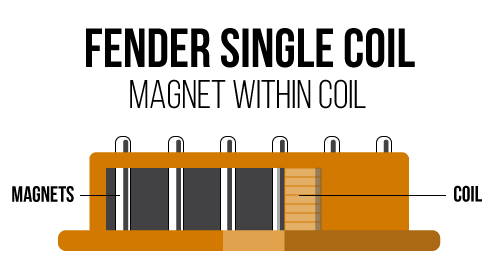

Other original pickup designs have their own ways of blending these components together, but the templates outlined in the above paragraph—magnets within the coils vs. steel pole pieces touching the magnets mounted below—describe virtually every type of pickup made for electric guitar.
The positioning of the magnet and presence of pole pieces are two of the most significant variables in pickup making, whether you’re talking humbuckers or single-coils. Gretsch Filter’Trons or Charlie Christians? Magnets below, with steel poles or blades threaded through the coils. Gretsch Dynasonics (aka DeArmond Model 200) or DeArmond Gold Foils? Magnets within the coils.
Put simply, each of these two basic designs has what we might call a “core sound.” Obviously there will be enormous differences between pickups depending on a wide range of other factors—more of which are below—but here are the broad characteristics enhanced by these two main approaches to pickup-making.
- Magnet within coil: Sharper, brighter, clearer, with enhanced treble. With individual magnet pole pieces, single-string definition is improved further; with bar magnets it’s often slightly “blurrier.”
- Steel within coil, magnet below: Rounder, thicker, grittier, snarlier and gnarlier, often with more aggressive midrange.
The Variables
Having understood these basic templates, it’s important to be aware that there are many variables at play which can make even pickups that seem to be the same type sound quite different.
Different magnet structures (or magnet-and-pole piece structures in many designs, as above) will respond differently, because they are creating different types and shapes of magnetic fields.
Different sized or differently structured pickups will create different magnetic fields and will “read” string vibration differently, which leads to different translations of the strings’ vibrations within the coil.
Different types of coils—whether wound in different shapes, in different patterns, with different gauges of wire, or with more or less wire—will translate the disrupted magnetic field differently, and therefore shape the signal sent to the amp differently.
Different formulations of steel components such as pole pieces, slugs, or base plates will contribute to subtle differences in different pickups’ sound and performance.
Different string types will affect the magnetic field differently. According to the type of steel they are made from, any coating or plating on the wound strings, their condition, their gauge, and other factors, a different performance could result from any given pickup.
Any given pickup, whether of the same type or an entirely different design, is the product of a handful of major variables and will sound different depending on how any individual ingredient—or a combination of several—is varied in the recipe. This starts with the makeup of the coil.
Coil Size: Is More Wire Better?
The most obvious factor in the makeup of any pickup coil is the length of the pickup wire, which determines the overall strength of the pickup. All else being equal, the more wire you have in any given type of pickup, the bigger the signal it will produce when you strum the strings and the more powerful it will sound.
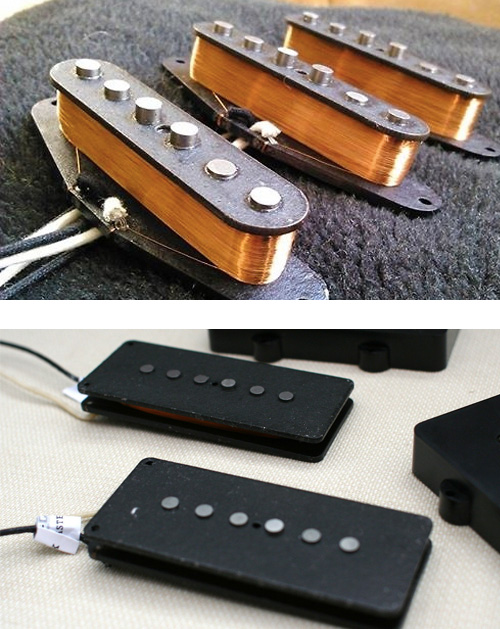
More wire doesn’t just mean a more powerful pickup to drive the amp harder; it also brings a change to the pickup’s frequency spectrum. Players who feel they want a “hotter” pickup might not also want that sonic alteration that comes with it. Adding more wire to a coil increases midrange response but attenuates treble and bass; the reverse applies for removing turns of wire from a nominal, tonally acceptable “standard” number of turns in any given design.
Up to a point, increasing a pickup’s midrange aggression by adding more wire can work to the advantage of a weak pickup with a harsh, brittle treble response, as the high strings will sound smoother and fuller with an increase in output coupled to a decrease in pure highs. However, the wound strings—which perhaps sounded just right as they were—will round out too, possibly becoming muddy or flabby or indistinct-sounding if the increase in winds is taken to extremes.
The main thing to consider here is that you usually can’t have it both ways: if you love the sound of a vintage-style, lower-wind pickup but also want a hot pickup to drive your amp harder, chances are you’ll have to compromise a little somewhere. The amount of wire is far from the only factor to consider here. The type of wire and the way it is wound into a coil are also of huge significance.
Gauge of Wire
Pickup makers use different gauges of wire to achieve different ends, although 42-gauge is the most common. If you start winding a typical Stratocaster pickup and keep going until it’s full, you might get to 8,000 turns of 42-gauge wire before you run out of room. If you want even more than that for a “hotter” pickup, you need to use thinner 43-gauge wire instead, which lets you increase the length of wire and to wind it on more tightly too.
Alternatively, if you’re designing a pickup from the ground up and space is too tight to allow enough 42-gauge wire for an acceptable output, you might use 43- or 44-gauge instead, just to get enough signal out of it without necessarily trying to make it hotter. Higher gauges were used in many old DeArmond pickups for just this reason, while several high-output pickups also use it to achieve their desired ends. Fender’s petite Telecaster neck pickup has traditionally used 43-gauge wire to get enough output from the design, which is notably smaller than a Telecaster bridge pickup or a Strat pickup.
As with the wire length, a change in wire gauge likewise introduces a change in sound. This change is likely to affect the balance of highs, mids and lows, the pickup’s relatively clarity or snarl, and other factors. Exactly how it affects these depends on other aspects of the design and how the coil is constructed, but be aware it will make a difference. Note, for example, that Fender’s very early 1950 Broadcaster bridge pickup used 43-gauge wire and had a bright, fat, somewhat gnarly-edged bite to it whereas standard Telecaster bridge pickups that followed were largely similar in construction but used 42-gauge wire and had a somewhat clearer, tighter, yet still meaty flavor of twang.
Insulation
All pickup coil wire is insulated, otherwise the coil would be one massive short-circuit within itself, but the type of insulation does have an effect on the way to pickup creates signal. Many great pickup makers will tell you that "wire is wire," while others will expound at length on the fact that insulation varies in thickness according to the material it is made from, which affects the inductance and capacitance of the coil.
Arguably, the insulating material also affects mechanical vibration and resonance within the pickup, according to how hard/brittle or absorbent it is. In these ways, a change in insulation coating material can indeed change the sound of the pickup in a very real way. The most commonly used insulating coatings are Formvar, plain enamel, and polyurethane. Each results in a slightly different thickness of insulation and different degrees of relative stiffness or flexibility in the wire.
Formvar-coated wire was used in Fender Stratocaster pickups until about 1964, when the company changed to plain enamel. This slightly thicker, heavier Formvar is the coating material you will hear bragged about most in the literature of contemporary winders keen to point out how rigidly they adhere to vintage Fender Strat specs.
Gibson used plain enamel-coated wire for both its P-90 single coils and PAF humbucking pickups, while Fender was always using plain enamel for its Telecaster pickups, so this type of wire has come to be an essential ingredient of any repro PAF or vintage-style Tele pickup. As for what is better or worse, that will depend on the overall design of the pickup and the tone you seek to achieve. It’s best to read makers’ specs and descriptions regarding their individual designs and trust the best pickup winders to use materials that they feel are right for the job.
The Way the Coil is Wound
The even- or unevenness, tightness or looseness, regularity or irregularity with which the wire is wound onto a pickup’s bobbin or coil former all play into how a pickup functions. These factors are introduced into the pickup’s construction by the winding technique, which is often influenced by whether the coil is wound on an automated machine (and what type of machine), on a machine with the wire hand-guided onto the coil as it builds up, or with even more hand work. Few pickups are truly “hand wound,” however, which is no surprise when you consider how much time it would take to turn a coil by hand 8,000 to 10,000 times to get all the wire on there! Instead, the hand element usually involves how the wire is fed or guided onto the coil as it spins on some motorized device.
Many pickups today are wound in an effort to replicate the “happy accidents” found in the randomness or irregularity of the best-sounding vintage pickups. Aficionados often attribute some of the magic of good vintage-style reproduction pickups to a degree of looseness in the wind, which translates to a slightly microphonic pickup. By “looseness” we’re not talking to the extent that wire is flopping around and the coil is changing shape or producing excessive feedback even at moderate volumes. But when a coil is acting both as a microphone that pickups up direct guitar-body resonance in addition to its electromagnetic sensing of string vibration, it’s conceivable that it is producing a richer, more complex signal.
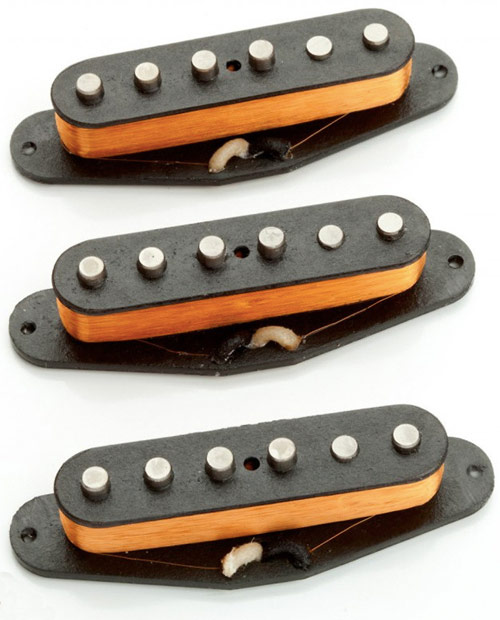
Similarly, the neatness and consistency with which the turns of wire are laid or layered into the coil is also responsible for certain sonic properties. The term “scatter wound” describes a coil that has been wound with a degree of calculated randomness. Manufacturers that employ this technique cite the arguably sloppy winding of some vintage pickups, where wire was not precisely layered as it formed around the bobbin, but occasionally made skips and jumps up and down the coil’s vertical plane. Coils might also be built up unevenly, with the wire stacked more widely or heavily toward the bottom or the center. Sloppy or not, scatter winding is also accredited with a liveliness of tone that many modern manufacturers seek to reproduce.
Others, of course, will boast of the superior precision and regularity of their turns, saying that it makes for superior-sounding pickups. A more tightly, evenly wound pickup is often considered smoother and clearer-sounding, less prone to feedback, and might genuinely be the preferred choice for players seeking singing contemporary high-gain lead tones.
In humbuckers, the effects of coil-winding are compounded since two coils will interact to produce a signal. In recent years, many makers have discovered that one of the keys to creating an accurate-sounding reproduction of the hallowed Gibson PAF is to combine coils with different numbers of winds—one with 3,800 turns of wire, for example, with another of 4,300 turns. Since these mismatched coils result in slightly less phase cancelation when their signals are combined, they are attributed with enhancing the bite, edge, and high-end complexity of the pickup, and lending a certain single-coil-like depth to the midrange and a clarity to the lows. Less phase cancellation also means a little less hum cancellation, so evenly matched coils excel in noise rejection, while also being smoother and even-sounding where that might be desirable.
Potting & Coil Shape
Many pickups are “potted” (dipped in melted wax or paraffin) to provide an overall dampening insulation within the coil windings to quell unwanted vibration and microphony, which can lead to feedback squeal at high volumes. Akin to what is discussed above, an un-potted pickup’s microphony can be another vintage-associated characteristic, enhancing bite, edge, complexity and harmonic content.
Finally, the basic physical shape of the coil will also influence how it sounds. Whether the same type and amount of coil wire is stacked up in a tall, narrow, vertical oval like a Stratocaster pickup (which tends to sound brighter and more focused), or a wider, fatter, more horizontally inclined oval like a P-90 (which tends to sound thicker and warmer), this shape can make a big difference in the final tone.
Consider Fender’s Jazzmaster and Stratocaster pickups: both have six alnico rod-magnet pole pieces and are held together by fiber top and bottom plates. Now wind the same amount of wire around both configurations and you will get pickups with similar output levels but significantly different sonic signatures: the narrow, tall Strat pickup will be tighter and brighter; the wide, thin Jazzmaster pickup warmer and thicker.
A big part of this goes back to the basics of the electromagnetic device. Building this structure around a different framework and thereby rendering the ultimate shape of the device differently also changes the structure of the magnetic field and leads to pickups that read string vibration slightly differently. Differently shaped coils also behave differently, even when loaded with the same type and amount of wire, because the wire is spread along a different geometrical pattern.
The wider pickup shape contributes to a wider magnetic window, which samples vibrations from a wider region along the length of the strings. A longer sample of the vibrating strings means more competing frequencies which, when blended, lead to a little phase cancellation and a slightly warmer, less defined, less brightly focused sound.
Many players will already be aware of two main categories of magnets used in pickup manufacturing: Alnico and ceramic. Some pickups are also made with rare-earth magnets like neodymium and samarium cobalt. For now, think of Alnico as the “vintage-voiced” magnet and ceramic as the “modern-voiced” magnet, while the rare-earth types might be considered “ultra-modern."
There are, of course, exceptions to the rules in all camps. With that in mind, it’s important to be aware that similar magnets of each type are used in very different ways in different pickup designs, so we don’t want to make any assumptions that “Alnico pickups all sound like this,” and so forth.
Alnico Magnets
The Alnico magnets commonly used in pickup manufacturing come in four different types, labeled with Roman numerals II through V. II and V are the more common of the quartet, with III and IV occasionally used by some makers. Each formulation of Alnico is differentiated according the composition of the alloy, and the numbers ascend according to the strength of the magnet. Alnico is nominally made up of aluminum (around 10 percent), nickel (around 18 percent), and cobalt (around 12 percent), usually with some copper (around 6 percent) and plenty of iron (54 percent) to complete the alloy. Some Alnico also contains a small quantity of titanium and traces of niobium.
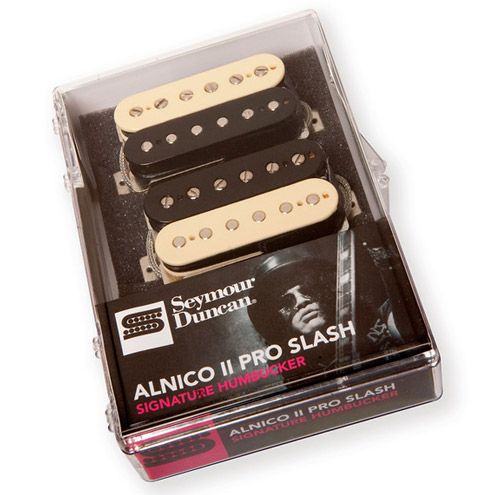
Whatever the exact ingredients—and even two different batches of “Alnico II” will arrive with slightly different proportions of these—Alnico II, III, IV and V do tend to exhibit slightly different magnetic characteristics and contribute to different-sounding pickups. Alnico II, the weakest of them, is a little softer and sweeter than the others. Alnico III is still rather soft but perhaps a little richer and slightly bolder. Alnico IV tends to be noticeably punchier than II and III, with more definition in the highs, while alnico V is bolder, clearer, and more aggressive still.
Please keep in mind this is comparing fine points, which are also accentuated or masked by other factors in any given pickup’s design and construction, so any differences attributable to magnet type might be nuanced at best. But they do point the way for thoughtful makers to dial in their recipes according to the tone and feel they seek from any given type of pickup.
Often, the choice of a particular formulation of Alnico will be made in an effort to chase a specific vintage tone, and based on what a manufacturer believes the original maker used to make those particular pickups in the 1950s and ’60s. In truth, you could probably plug in a guitar loaded with pickups made with Alnico II, III, IV or V magnets and describe all of them using any of the characteristics I have used above. You might even elicit similar flavors from another pickup made with ceramic magnets.
Ceramic Magnets
Cheaper to produce and more readily available than Alnico, ceramic (aka ferrite) magnets sometimes get a bad rap in the pickup world, but that’s largely from the way they were used in the early days of ceramic pickups and not due to any failing in the material itself. Ceramic magnets are made from iron oxide that is molded or pressed into a solid form with other compounds. They are capable of producing a lot of magnetism for their given size and tend to remain stronger throughout their lifetime.
This magnetic material first became popular in pickups in the ’70s, when makers (or modders) replaced the Alnico magnets in pickups that were designed to use them with stronger ceramic magnets, sometimes over-winding the coils in the process, and bam: hello high-output pickup. The power of these things impressed many players four decades ago, winning fans in rock circles for their ability to drive the front-end of many tube amps into easy distortion. The problem is that distortion was too often thick, muddy, and flabby, with ragged lows and harshly clipped highs. But this isn’t the fault of ceramic magnets, it’s just how they were being used.

High-output ceramic pickups have their place, certainly, but they shouldn’t be considered representative of “the ceramic pickup” as a whole. There are dozens of other excellent designs that employ ceramic magnets effectively. A number of excellent sounding G&L pickups, for example, (including many designed by Leo Fender himself) use ceramic magnets, as do highly respected “boutique” pickups from Joe Barden, Bill Lawrence, and plenty of excellent designs from DiMarzio and Seymour Duncan.
While the latter two makers often use ceramic magnets in pickups intended for heavy rock and metal players (although they do so today with due consideration of the full range of factors associated with ceramic magnets), many pickups from G&L, Barden, and Lawrence aim to attain vintage-voiced sweetness and unprecedented clarity in pickups that appeal to jazz, blues, and country players as much as to rockers.
The designers of more nuanced ceramic pickups achieve their success by redrawing the blueprint, to some extent at least, and conceiving their pickups from the ground up with the properties of ceramic magnets in mind. This means, among other things, adjusting the number of wire turns considerably downward to maintain a broad frequency response and achieve a clean, dynamic performance. Simply substituting ceramic for Alnico as a hot-rodding effort, as was often done in the early days, usually results in a big but flat voice and works for little else than super-high-gain rocking. Redrawing all the parameters accordingly and working with ceramic’s strengths, these makers produce pickups that are nuanced, musical, and extremely well defined. Depending upon what you do with them, you can convince your ears that they are “vintage sounding” or entirely “modern.” In the end, they are simply something different.
Rare Earth Magnets
Some clever pickup makers have also used rare earth magnets in new designs in recent years. Tom Anderson uses neodymium in some of his more contemporary styled pickups, and Bill Lawrence has employed samarium cobalt in a range of pickups designed for Fender. Magnets made from these rare materials are very expensive but also extremely powerful—as much as seven times as powerful as ceramic magnets of a comparable size—so much less magnetic material is required in the construction. On the whole, such magnets contribute to pickups that exhibit high fidelity and a broad frequency response.
Ultimately, what the detractors of these high-end ceramic or rare earth pickups might hold against them most is their unfamiliarity. A player’s first experience with something like a set of Joe Barden S Deluxe pickups can be daunting. Often, guitar and amp settings and playing style all need to be adjusted to account for the clarity and resolution that high-fidelity ceramic pickups such as these will present, and sometimes the experience is just too revealing for some players to enjoy. Others very much appreciate their sensitive, hair-trigger expressiveness.
Magnet Structure and Positioning
Any difference in the type of magnetic material will alter the “gauss” of the magnet—that is, the strength of the magnetic field and the extent to which it reaches out beyond the pickup itself. The size of magnet used, the way in which this magnet is built into the pickup, and its position in or below the coil will also affect the reach of the magnetic field. So, even the exact same magnet material with the same gauss will result in two different magnetic fields in differently structured pickups.
Regarding the magnets themselves, though, it’s important to remain aware that different shapes and sizes of what is otherwise the same material will lead to differing magnetic strengths and slightly different tonal responses. Alnico magnets are most visible as the pole pieces of Fender single coil pickups, where six are used in each of the traditional Stratocaster, Telecaster and Jazzmaster designs, one visible under each string. As used in these great golden pickups, the magnets are inserted right into the bobbins (or more accurately, the “flatware,” the flat fiber top and bottom plates of the pickup), and therefore are contained right within the coil itself.
The other most popular pickup types, the Gibson PAF-styled humbucker and Gibson P-90, also use alnico magnets, but they are hidden beneath the pickup—or rather, between the bottom of the bobbin and a base plate that holds the entire structure together. These pickups use alnico bar magnets—one magnet in the case of the PAF, two in the P-90—which transfer their magnetic properties to steel pole pieces that run through the coil(s). The poles you see on these pickups are not the magnets themselves, although they do react with the magnet and help to determine the magnetic field.
Differences in the positioning of the magnet(s) and the shape of the magnetic field are significant factors in the overall design of any pickup, and they play a big part in determining a pickup’s voice. A wider magnetic field—something produced, for example, by the two rows of pole pieces within the two coils in a traditional Gibson humbucker—means a wider window for sensing string vibration and a relatively thicker, fuller, warmer sound as a result.
A PAF-sized humbucker will sound “fatter” than a narrower mini-humbucker wound with exactly the same amount of wire and built with the same type of magnet, largely because of its wider magnetic window. (Note that Gibson’s full-sized and mini-humbuckers are not made the same way and with exactly the same amount of wire and magnetism. But if they were, they would still sound slightly brighter.)
Supporting Structures
Every magnetic metal component involved in the construction of a pickup can (and usually will) influence its magnetic field to some extent, so all such parts also play a role in shaping any pickup’s sound. It’s no surprise that the individual steel pole pieces in a PAF-style humbucker or P-90 single coil have an impact on such pickups’ performance, since they play a big part in relaying the magnetism from the actual magnet(s) mounted below the coil to the strings passing above it. But the shape, density and composition of any other steel parts used in those pickups’ construction will also influence the magnetic field, and the pickups’ sounds as a result.
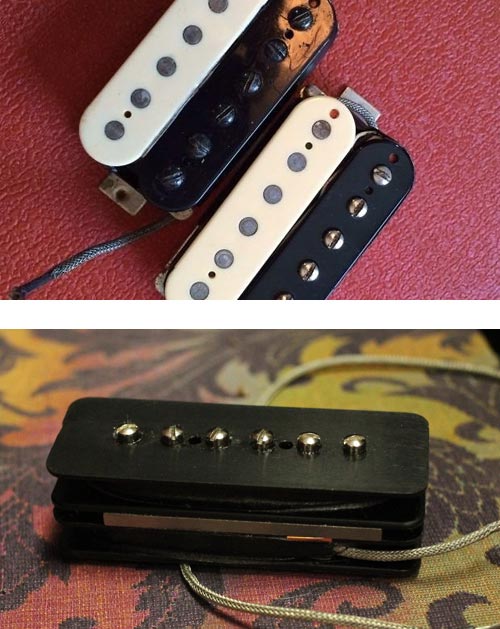
Most players have heard the tip about removing the metal cover from a humbucker to increase high-end response (which may or may not be a good thing, depending on what you’re after—and may or may not also damage a valuable pickup in the process), but few consider that, for similar reasons, a pickup’s metal base plate or other structures will also influence its magnetic field, its microphony, and other factors related to its performance. It’s difficult to say here exactly how such parts will affect different types of pickups, and it varies from pickup to pickup and from material to material, but the fact is worth remaining aware of.
Looking at an entirely different type of pickup, it’s worth noting that the metal base plate stuck to the bottom of a Telecaster bridge pickup, which enables it to be mounted on the three threaded bolts that suspend it from the bridge plate, also has an impact on this type of pickups’ sound.
The base plate—in conjunction with the steel bridge plate itself via the three metal bolts—increases the Tele pickup’s inductance and marginally thickens its midrange response while also playing a role (again, in conjunction with the traditional Telecater bridge structure itself) in the overall resonance and “liveliness” of that pickup design, as used in that particular type of guitar.
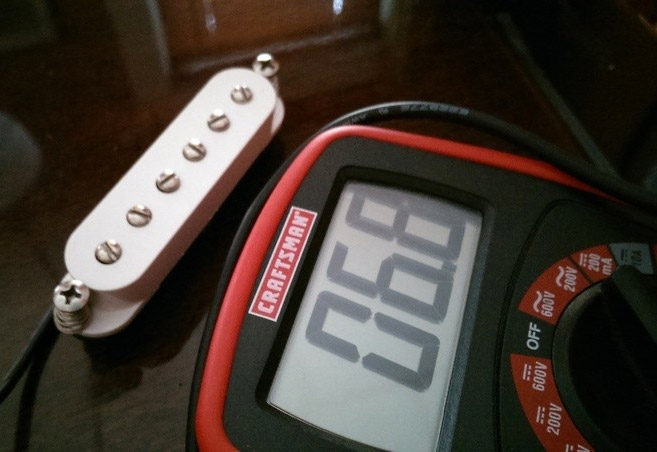
Resistance and Impedance
“Resistance” is the measurement (taken in “Ohms”) of a coil’s opposition—or “resistance power”—to a DC current. The same measurement of an AC component is called “impedance,” and it is also recorded in Ohms. Look up the specs of almost any pickup and you’ll see a figure for resistance, which is intended to tell you how “powerful” the pickup might be.
For a Stratocaster pickup, for example, it might say 6.2k Ohms (where “k” means “times a thousand,” or 6,200) for a more vintage-voiced product. The conundrum in all of this is that standard electromagnetic guitar pickups create an AC signal, but we tend to measure only their DC resistance, simply because this is easier to do. As such, these specs that proliferate pickup-makers’ websites don’t do the full job of telling you how hot or powerful any pickup is. They do, however, go some way toward helping you build up a picture of the pickup’s characteristics once you know some other details and have several others with which to compare it.
Essentially, any pickup’s resistance measurement just tells you how big the coil is—that is, how much wire is wound around it—or how big the two coils combined in series are if it’s a humbucker. The trouble with using this as a set standard, however, is that different gauges of wire yield different resistance readings for the same given length. Thinner wire gives higher resistance readings, so you can be fooled into thinking such pickups are hotter. In fact, a lesser length of 43-gauge wire will yield a higher reading than a somewhat greater length of 42-gauge wire, so two otherwise similarly constructed pickups will not only sound different because of the different wire used, they will give very different resistance readings.

In addition, many of the more thoughtful pickup makers will tell you that “resistance readings mean nothing” when trying to gauge the sound of any pickup. For the most part, they’re right. They do mean something if you know all the other factors in a pickup’s design and construction and are using specs for resistance merely as a gauge to judge likely nuances between one pickup and others that are constructed identically in everything other than coil size (i.e. length of wire used). To that end, any weight given to resistance readings should only be considered in light of all of the other things we have examined.
With that in mind, they might help to get you somewhere. For example, consider six similarly designed PAF-style humbuckers made with the same materials. Attach six different DC resistance readings to these, and you can guess that the 6.85k-Ohm pickup might sound a little thin, bright and under-gunned in the bridge, but snappy and round in the neck. The 9.2k ohm pickup is likely to sound a little too fat and muddy in the neck, but will be meaty and thick in the bridge, and so on, with all sorts of gradations in between.
Generalizing more broadly about a wide range of pickups’ power, or so-called “output,” by using DC resistance as a yardstick can be misleading. A pickup’s resistance doesn’t measure anything being “put out” at all, but is a static measure of its coil at rest (taken with a specially designed meter) and simply reads the number of turns of X-gauge wire that have been wrapped around the coil. More or less turns of wire in a coil of a specific design will yield a more or less powerful result, respectively, but comparing the resistance readings of a Strat pickup, a Tele pickup, a Gibson P-90, and a Gretsch Filter’Tron will get you nowhere. Even if all read exactly 6.5k ohms, they would sound very different and even exhibit distinctly different output levels, driving your amp to varying degrees.
Inductance
Inductance is measured in a unit called “Henries,” and to put it in simplified terms, such a reading tells us how “fat” a pickup will sound. As a general rule, the higher the inductance, the more restrained the high end and the thicker the mids and lows.
While resistance is a pure measure of how much of any given gauge of wire is wound around the coil, inductance can be affected by other things. Unusual or irregular winding patterns, metal components in contact with the magnet, coil structure and other factors can all raise a pickup’s inductance above what the raw coil might read on its own.
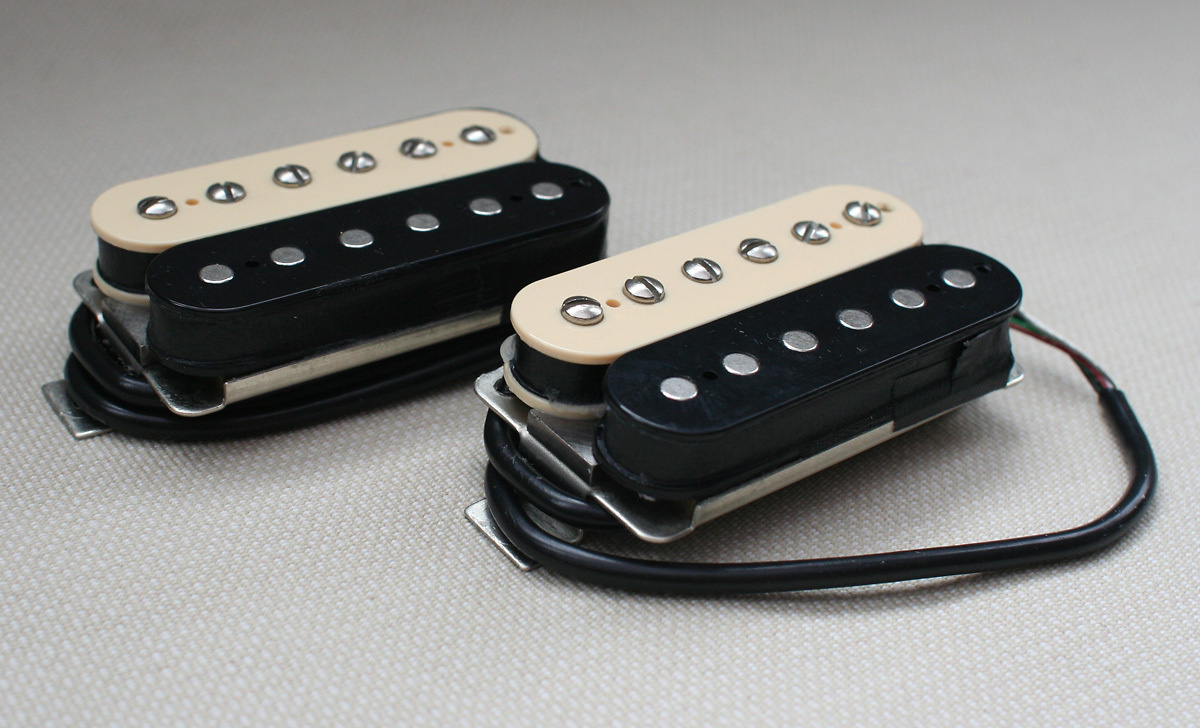
To provide some examples, the average Stratocaster pickup will have an inductance of between 2 and 2.5 Henries, while the average traditional PAF-style humbucker will register something above 4 Henries. The average Telecaster pickup, on the other hand, will read a little over 3 Henries. Fewer pickup makers provide specs for inductance than for resistance, but it’s something that more and more people are aware of, and you can usually find it if you poke around or simply ask.
About the author: Dave Hunter is a writer and musician who has worked extensively in the USA and the UK. He is the author of The Guitar Amp Handbook, Guitar Effects Pedals, and Guitar Amps & Effects For Dummies among others. Dave is also a regular contributor to Guitar Player and Vintage Guitar magazines.
